
Image credit: NASA
A satellite designed to track the changes in the Earth’s major ice sheets was launched on Sunday after experiencing a month of delays due to technical difficulties. ICESsat (Ice Cloud and Land Elevation
Satellite) was launched aboard a Boeing Delta rocket from the Vandenberg US Air Force Base in California. On board the rocket was another, smaller satellite called CHIPSat, which will help astronomers study the hot gas coming off of stars.
NASA?s Ice, Cloud and Land Elevation satellite (ICESat) and Cosmic Hot Interstellar Spectrometer (CHIPS) satellite lifted off from Vandenberg Air Force Base, Calif., at 4:45 p.m. PST aboard Boeing?s Delta II rocket. Separation of the ICESat spacecraft occurred 64 minutes after launch at 5:49 p.m. PST. Initial contact with ICESat was made 75 minutes after launch at 6 p.m. PST as the spacecraft passed over the Svalbard Ground Station in Norway.
The CHIPS spacecraft separated from the launch vehicle 83 minutes after launch at 6:08 p.m. PST. Initial contact with CHIPS was made 98 minutes after launch at 6:23 p.m. PST as the spacecraft passed over the University of California, Berkeley.
?The Delta vehicle gave us a great ride! The ICESat spacecraft was right where we expected and is performing great. The whole team is thrilled to be having such a wonderful start to our mission? said Jim Watzin, the ICESat Project Manager at NASA?s Goddard Space Flight Center in Greenbelt, Md.
Over the next few days the ICESat spacecraft will gradually be despun and placed into a safe stable attitude. Within two weeks the onboard propulsion system will gradually tune the orbit. Once in its final orbital position, ICESat will be approximately 373 miles (600 kilometers) above the Earth.
ICESat is the latest in a series of Earth Observing System spacecraft, following the Terra satellite launched in December 1999, and the Aqua satellite launched earlier in May of this year. The primary role of ICESat is to quantify ice sheet growth or retreat and to thereby answer questions concerning many related aspects of the Earth?s climate system, including global climate change and changes in sea level.
Ball Aerospace and Technologies Corporation (Ball) in Boulder, Colorado built the ICESat spacecraft. The Earth Science Data and Information System at NASA Goddard will provide space and ground network support and the University of Colorado?s Laboratory for Atmospheric and Space Physics will team with Ball to provide mission operations and flight dynamics support. The GLAS and ICESat data will be initially processed at the ICESat Investigator-led Processing System with support from the University of Texas, Center for Space Research. The mission data will be distributed and archived by the National Snow and Ice Data Center.
Original Source: NASA News Release
